A party from RBGE was invited to see the recent restoration work undertaken by Janis Binnie on the plantings in the lower part of Leny Glen, Callander, Perthshire. To the Himalayan botanist this is sacred territory as, following his return from India in 1815, Leny was the home of Dr Francis Buchanan. In order to inherit his maternal estates from his brother in 1818 he had to take the name of Hamilton and as Francis Buchanan Hamilton (FBH), he lived at Leny until his death in June 1829. In the Glen beside the house he developed a woodland garden:
at an expence [sic] of several thousand pounds … intersected with gravel walks, and the shrubbery filled with the rarest foreign plants and trees of every description, forming the most delightful pleasure grounds.
The ‘foreign plants’ included Himalayan ones supplied by Nathaniel Wallich, FBH’s indirect successor at the Calcutta Botanic Garden. As the first British botanist to have spent a significant period in Nepal (in 1802–3) FBH had a particular interest in the Himalayan flora and its geographical affinities. One of the purposes of our visit was to establish if any of the plants, especially rhododendrons and conifers, might date back to FBH’s time or whether they were the result of the continued development of the garden under his son John Hamilton Buchanan (1822–1903) and grandson John Hamilton Buchanan (1861–1919). The party consisted of Mark Watson (for his Nepalese interests), David and Maria Chamberlain to look at rhododendrons (with mosses on the side), and myself. We found ourselves there on Friday 30 April, a sunny, but cool, day.
Mark and I had last visited Leny in August 2006, when it belonged to Alan and Frances Roebuck. It was on then that we rescued FBH’s fallen and rapidly eroding marble grave marker for conservation and preservation at RBGE. Access to the Glen, said to be an impenetrable thicket dominated by the dreaded ‘ponticum’, was then impossible. On that occasion I did, however, make a mental note of a large specimen of the West Himalayan spruce (Picea smithiana) in the park close to the south-west of the house. Over the last decade access to the Glen has been greatly enhanced with a track usable by 4-wheel-drive buggies, and improved drainage of the lower, boggy part. Over the last two years Janis and her partner Ian Martin have contributed substantially to garden projects.
On meeting Janis and Ian the first of several extraordinary connections emerged. Among his other talents Ian turned out to be a fish biologist, who has worked extensively in Nepal on polymorphism in the mahseer (Tor putitora) in the Mahakali River. This large fish (a famous challenge to anglers) was described in 1822 by FBH as Cyprinus putitora, in his pioneering Fishes found in the River Ganges and its Branches, where he wrote that the fish ‘sometimes grows to nine feet in length’.
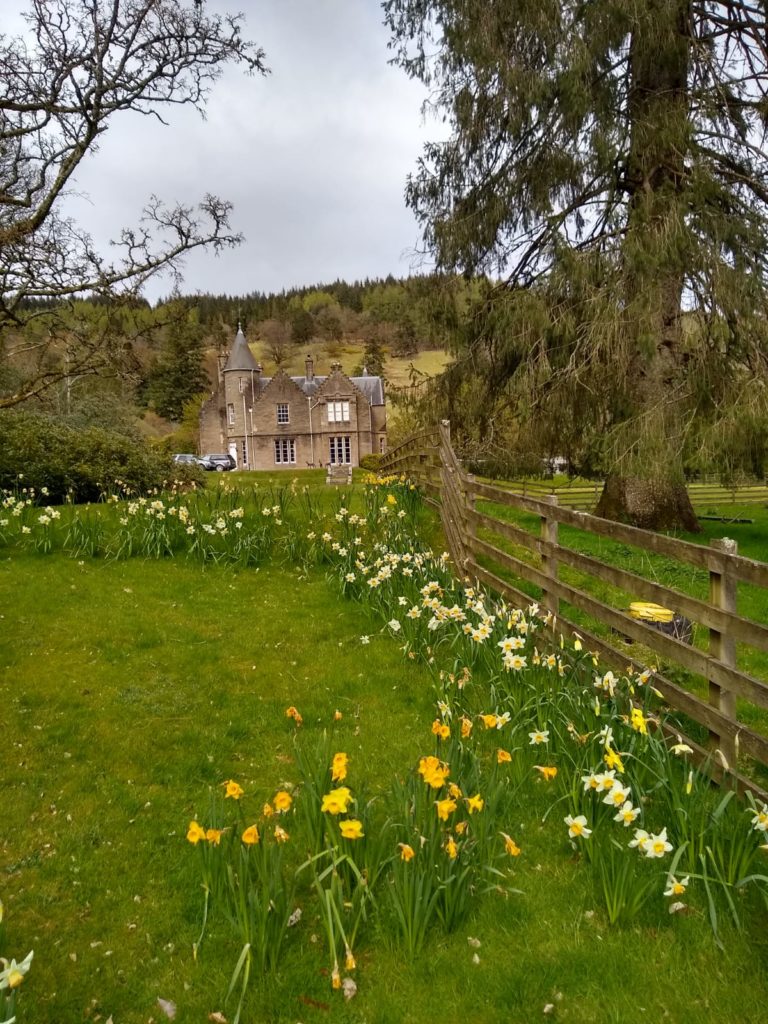
The Chamberlains arrived, Maria straight from a second Covid ‘jag’. David’s presence was crucial to the exercise for his encyclopaedic knowledge of temperate rhododendrons. It was only by identifying these and their geographical origins (and therefore the earliest possible dates of their introduction) that would allow informed speculation as to any connections with FBH. Until the 1970s much Rhododendron taxonomy was based on specimens grown in British gardens of the ‘great and good’, who had a vested interest in species inflation. There was no appreciation of the extent of hybridization in the wild, or even of that which had taken place in gardens, deliberately or accidentally. The project to revise the genus undertaken at RBGE in the 1970s and ’80s by David and by James Cullen proved game changing. Cullen never saw any of the species in the field and his work was largely based on herbarium specimens. David’s work coincided with the reopening of China to botanical expeditions and he was among the first post-War Western botanists to see Chinese rhododendrons in the wild. His travels embraced the whole Sino-Himalayan range: from Kashmir to the Khasia Hills in India, the Chinese provinces of Yunnan, Sichuan and Guizhou, and the mountains of Vietnam. The plasticity of species, and the extent of hybridization, became abundantly clear. In the popular imagination a curious mystique is given to the description of new species, but a good taxonomist performs a perhaps more useful task in recognising the synonymy of superfluously described species: an equally pertinent question to ask, especially in genera such as Rhododendron, would be ‘how many species have you sunk?’ We were invited into the house for what by now were ‘twelveses’. From the drawing room where we looked out over the park towards Callander it was not, however, possible to imagine that we were sitting where FBH once had, as this was in the part of the house built by his son in 1846. David Bryce remodelled the house for John Hamilton Buchanan, adding a substantial L-shaped wing to the south and west, mirroring the original 17th century north and east wings. The addition is in baronial style, but on a more domestic scale and somewhat less turreted than the extravagances Bryce produced for institutions such as Fettes College or the houses of titled magnates.
We then went to the foot of the Glen to see the progress Janis has achieved, single-handedly, in the Herculean task of clearing the ponticum jungle to expose its much more interesting Asian congeners, some of which, with massive, gnarled trunks, were clearly of considerable age. Above the shrubs elegant conifers soared skywards; there were also two massive sycamores, believed to be more than 400 years old, and oaks of a similar age. The rhododendrons, while attractive, turned out to be ambiguous in terms of potential links with FBH. Certainly there were several Himalayan species, including huge and venerable specimens of R. campanulatum and R. barbatum (its crimson flowers blasted by the recent unseasonal frosts), both species that could both have come from Nepal; two specimens of the former might, just conceivably, be two centuries old. The blackcurrant-coloured R. niveum, however, comes from Sikkim and Bhutan, and it seems perhaps more likely that the specimens of all these Himalayan species (which included R. campylocarpum and R. wallichii) date from the latter half of the 19th century, following Joseph Hooker’s 1848 discovery of the Eastern Himalayan rhododendrons and their introduction to British gardens. A second geographical category of species Rhododendron, including R. pachytrichum and R. strigillosum, originates from Sichuan and Yunnan, and must have been planted in the early 20th century, possibly from collections made by E.H. Wilson.
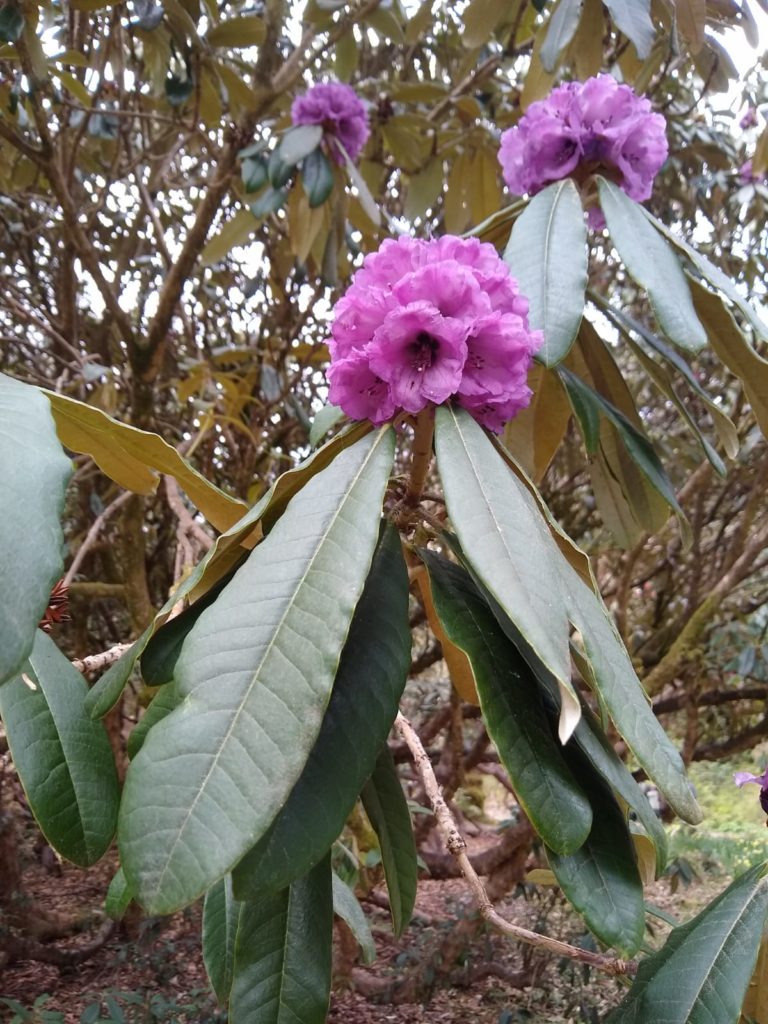
Regrettably no written records of the garden plantings survive. The contents of the house, including the library, were dispersed in the 1950s following the death of the last (collateral) member of the family, though some of the family records went to what is now the National Records of Scotland. What do, however, survive are fine photographs of the policies (including the walled garden and the Glen) taken around 1905 by John Hamilton Buchanan. Some of these were given to David Prain in connection with his invaluable biographical memoir on FBH and survive at Kew. Others were published, but with no descriptive letter-press, in a limited-edition book titled Photographs of Trees & Shrubs in the Garden of Leny, Perthshire, a copy of which is in the RBGE library.
The majority of the old rhododendrons in the Glen, and beside the walled garden, proved to be hybrids. From the impressive size of their trunks these probably date from the latter half of the 19th century, their parentage involving the Himalayan species R. arboreum and R. thomsonii, and North American species such as R. catawbiense. It was disappointing that there was no pure R. arboreum, but this is perhaps unsurprising as the species isn’t completely hardy in Scotland and, although sheltered and damp, Leny lies far inland and on the very edge of the Highlands. One of the aims of the mid-19th century hybridizations was that hardiness might be combined with the brilliant scarlet flowers of R. arboreum: the results were known as ‘Ironclads’.
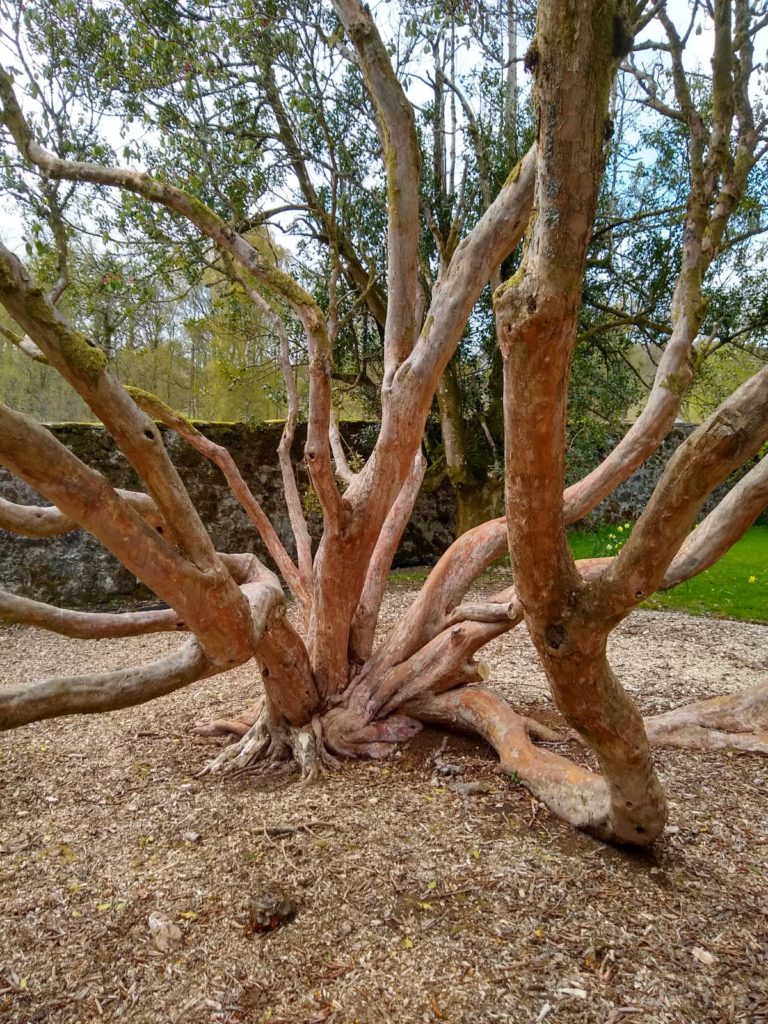
In the lower part of the Glen are two western hemlocks (Tsuga dumosa) that must be among the tallest in the country. The same applies to a huge sitka spruce (Picea sitchensis), which, under favourable conditions and when allowed to reach maturity, reveals a majesty that quashes the aversion felt when it is seen massed in plantations by the Forestry Commission. On the slopes either side of the Glen and in the surrounding parkland are several large Wellingtonias (Sequoiadendron giganteum), which cannot date before the 1860s. As the West Himalayan spruce and two deodars (Cedrus deodara) on the eastern side of the Glen are similar in size to the Wellingtonias, and despite their Himalayan origins, these trees probably all date from the same period. This is confirmed by the c 1905 photographs, in which all these trees are of modest height.
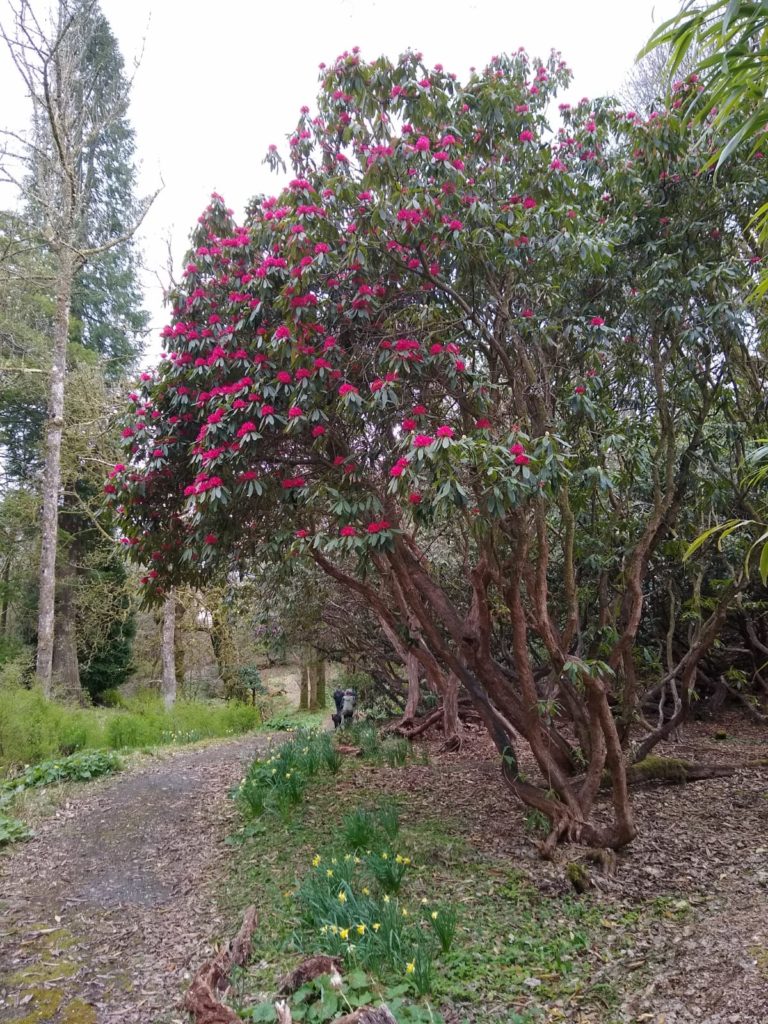
We continued into the upper part of the Glen, which is in different ownership, but where the interesting rhododendrons continued (more R. barbatum and a single non-flowering R. rex subsp. fictolacteum – the only large-leaved species seen, but a Chinese one). Here the land rises steeply and amongst the jungle are many native oak trees, remnants of the original forest of oak, birch and alder, a valuable commercial resource that in the 18th century was managed by felling and coppicing on a 16 to 25 year cycle for tan bark, and for making charcoal for the famous Carron Iron Works.
In the lower Glen it was not only the woody species that were of interest. Carpeting the damp ground along the Leny Burn, among extensive clumps of white butterbur (Petasites albus), was a sward of a conspicuous but unfamiliar Crucifer , clearly a species of bitter-cress. Its white flowers were intermediate in size between those of Cardamine pratensis and C. flexuosa and of a curious habit. The flowering shoots were leafless, the leaves all radical, arising from extensively spreading rhizomes; it was these that betrayed the plant’s identity – C. trifolia. This turns out that be one of only three naturalised populations recorded in Scotland. The three, stalkless, overlapping leaflets are attractive – lime-green, rhombic with toothed margins – and curiously the next day Mark saw the plant for sale in the New Hopetoun Garden Centre for £7.45 a pot. If the price doesn’t put people off perhaps more naturalisations can be expected in the future?
In the damp undergrowth my eye fell on a scurfy, whitish-green patch of what I took to be a liverwort, with flattened, leafy stems. David identified it as the moss Hookeria lucens, which set off a chain of associations, as the genus was named by James Edward Smith for his young Norfolk compatriot, the then 23-year old William Jackson Hooker. Hooker had found the moss near Holt, the second of his notable bryophyte finds, following that of Buxbaumia aphylla, which had proved his entrée into metropolitan botanical ‘Society’.
The moss was known to Linnaeus as Hypnum lucens and, like many bryophytes, has a worldwide distribution. The Rev John Lightfoot had found it ‘by the sides of rivulets, in dark shady woods, but not common’ in Scotland on his tour with Thomas Pennant in 1772. And in 1794 Archibald Menzies (like Smith and Buchanan, a student of John Hope), had found it in the North Pacific on Nootka Sound. The paper in which Smith established the new genus was written in Norwich in 1808 and published the same year in the Transactions of the Linnean Society of London. Another paper in the same issue of the journal is by Hooker, on none other than the mosses collected by FBH in Nepal. The specimens were in Smith’s herbarium, and had been given to him with the Nepalese flowering plants in the hope that he would publish them. Most, however, were destined to remain unstudied in the herbarium in Norwich. Only a small number of the flowering plants were described by Smith in his own Exotic Botany and in Rees’s Cyclopedia. Hooker, as a young protégé was one of the few allowed to study them and the paper, with accounts of 17 species (ten of which were new to science) of the ‘Musci Nepalenses’, is one of very few early uses made of FBH’s Nepalese collections. The connection between Smith and FBH went back to their time as medical undergraduates at Edinburgh in 1782, when Smith had formed the Society for the Investigation of Natural History, of which FBH was a founder member at a time when mosses were his main botanical interest.
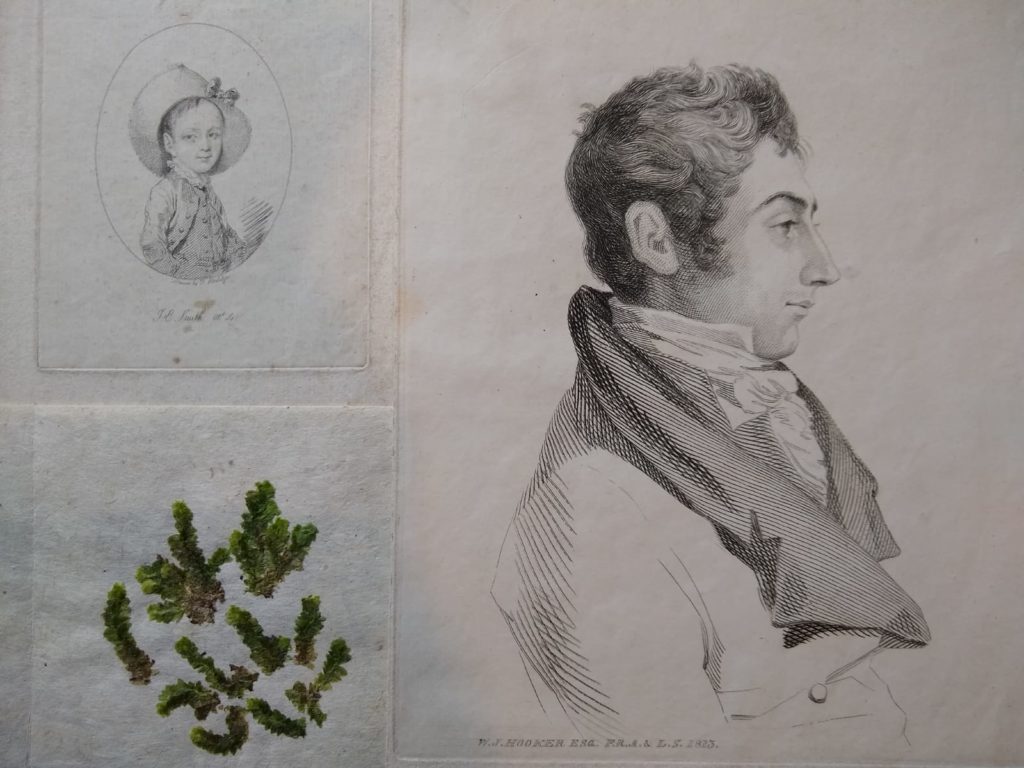
In 1820 Hooker was appointed to the chair of botany at Glasgow, from where he made annual excursions to the Highlands – to teach students and to collect and record the flora. On at least one of these excursions he visited FBH at Leny. Hooker sketched the house and must beyond doubt have been shown the recent plantings in the Glen. But he was not the only famous botanist relevant to this tale to have visited Leny in FBH’s lifetime, and it is astonishing to think that Wallich, a Calcutta-based Dane, also came here. In 1828 Wallich arrived in Britain on what would turn into a four-year furlough, during which he curated and distributed the major part of the enormous herbarium he had accumulated in Calcutta on behalf of the (British) East India Company. During this period he scarcely left London but soon after his arrival, in late September and early October, he made a brief iter septentrionale. On 5 October he wrote to Hooker from Edinburgh:
I spent a most delightful day & night at Dr Hamilton’s, whom I found in better health than I expected – tho’ he is multum mutatus ab illo [greatly changed], whom I knew 13 years ago. But his mind & heart are still the same: generous, warm & full of knowledge beyond, almost, all other Indian examples known to me.
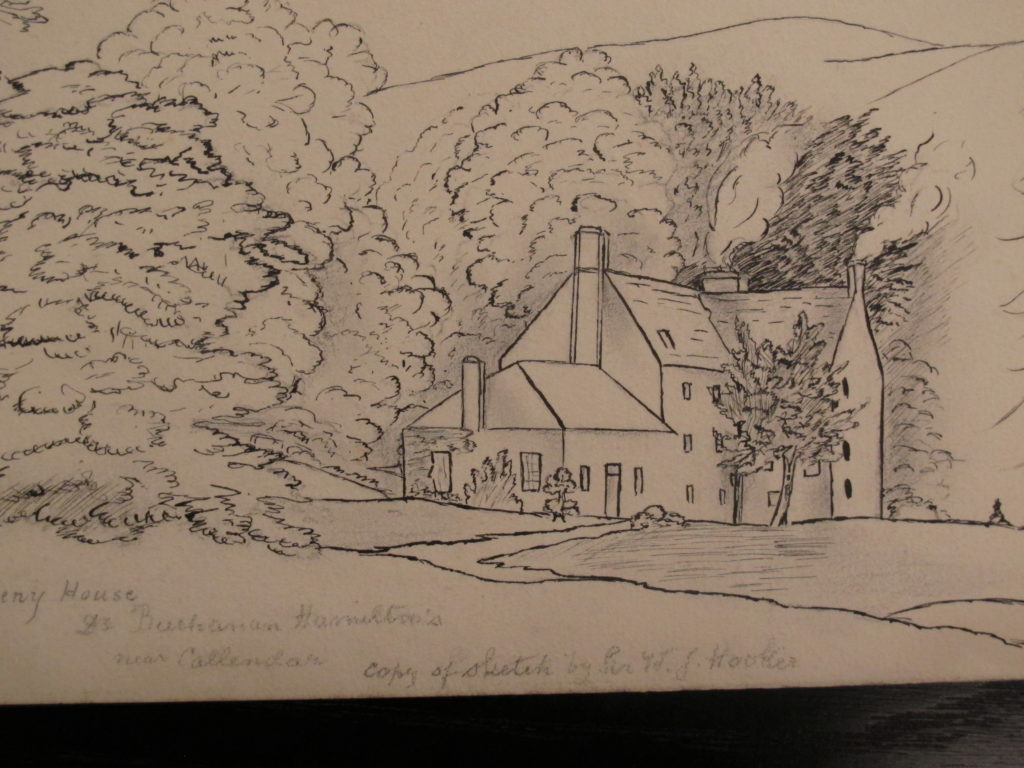
The day ended with a pilgrimage to the small family burial enclosure at the bottom of the as yet unrestored Leny walled garden. A peaceful spot where the sun streamed through the translucent shuttle-cocks of the fern Matteucia struthiopteris (also naturalised in the Glen). Widely dispersed around the walls are memorial tablets to FBH’s father (Thomas Buchanan of Spittal) and his descendants, and it was the first time I had seen the one for FBH made by Graciela Ainsworth – a replacement in more resistant stone for the original that is now mounted on the wall in the foyer of the RBGE Herbarium.
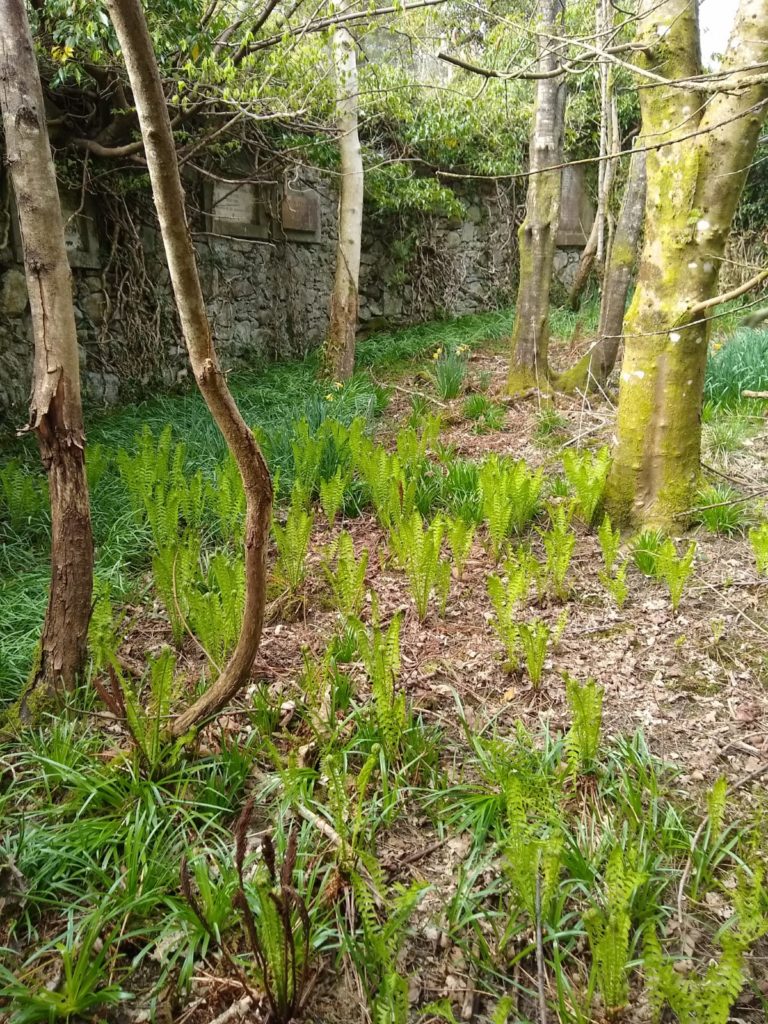

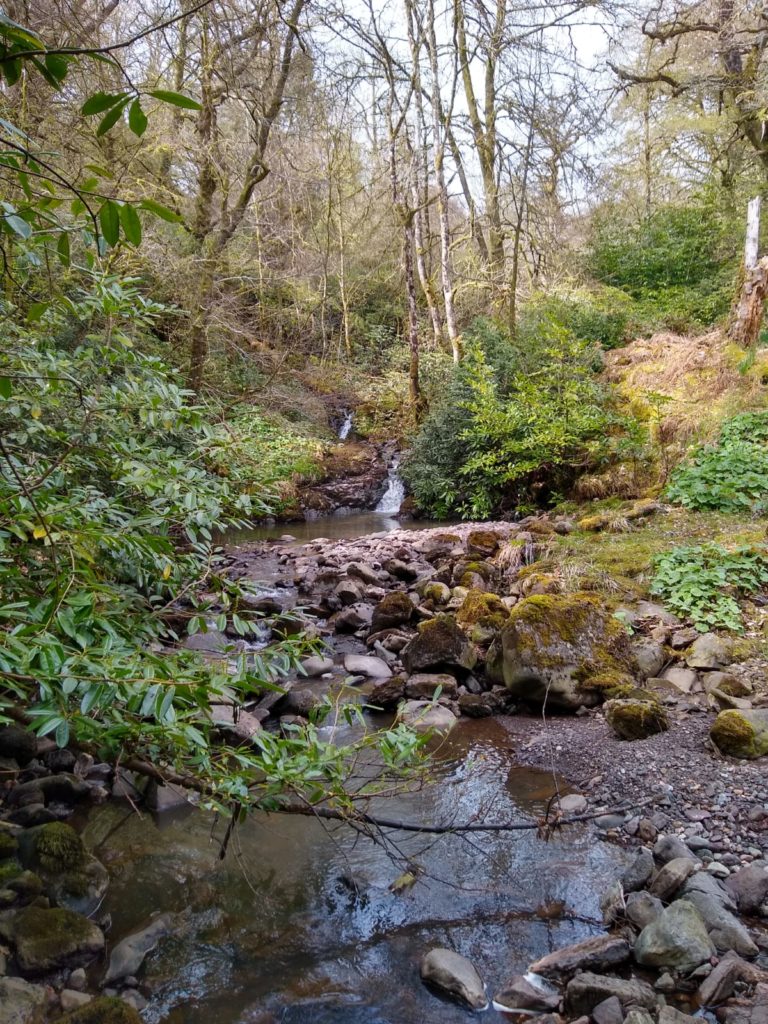
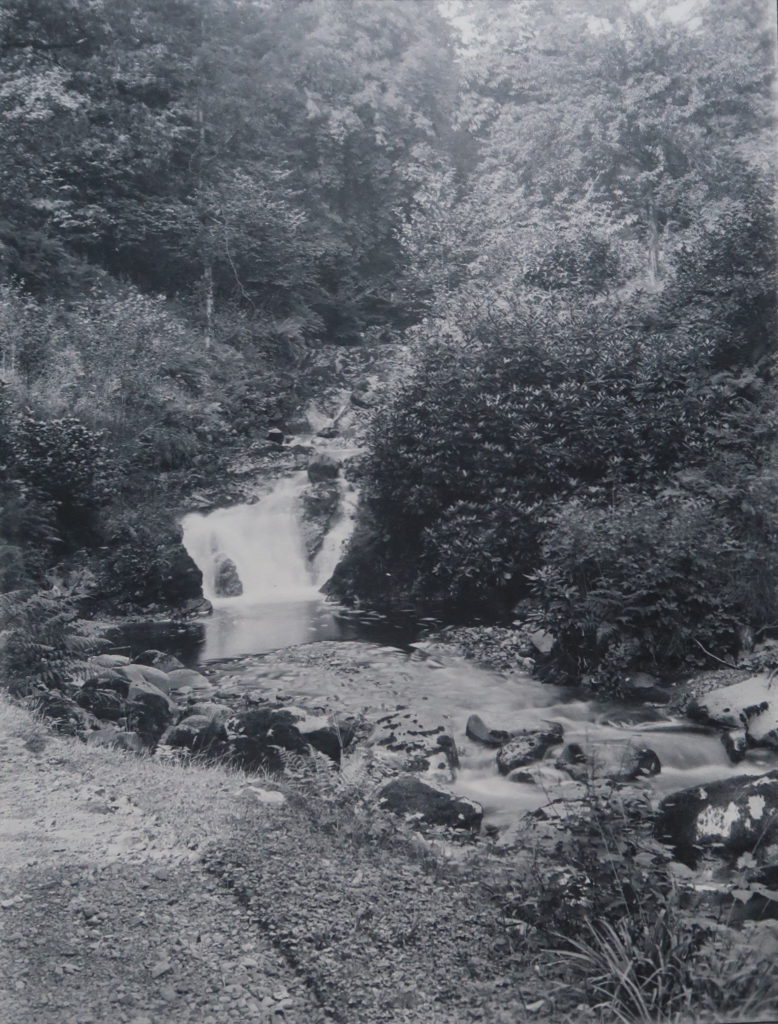
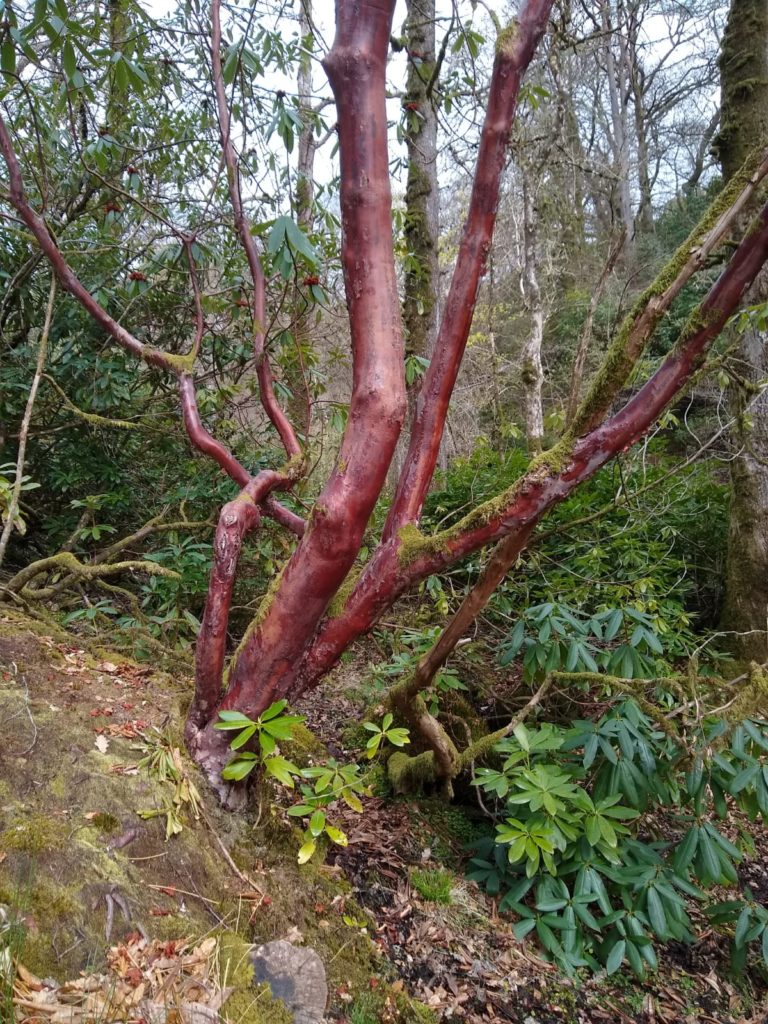
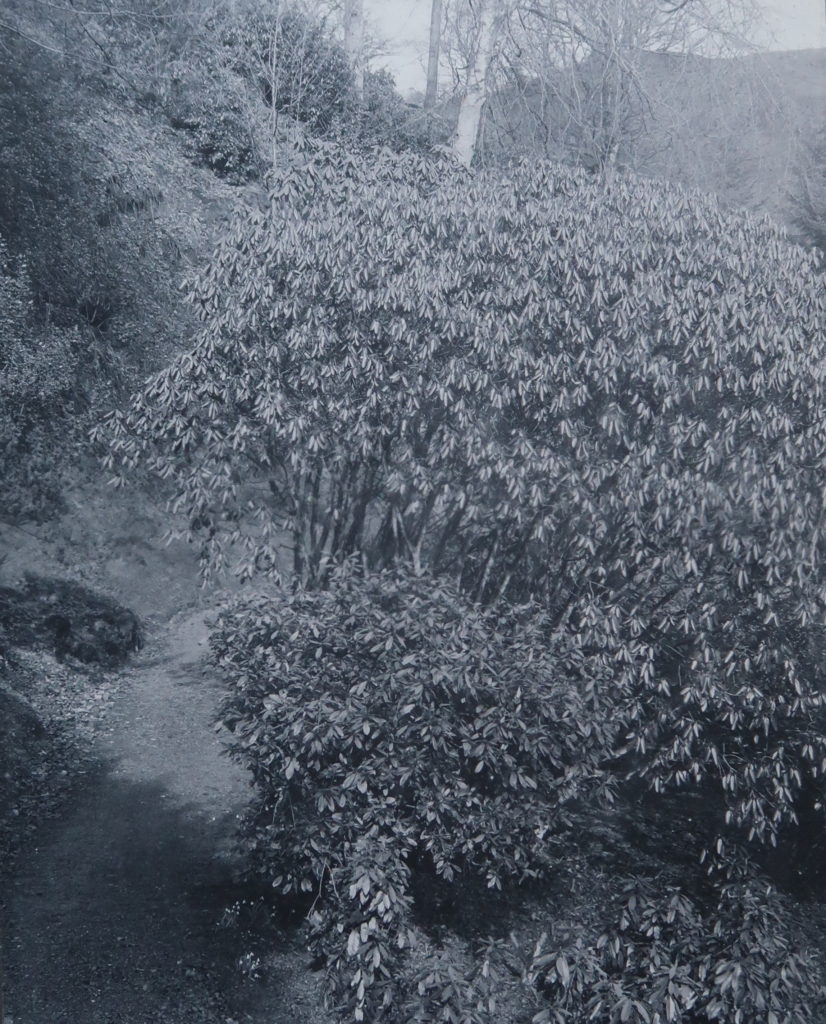
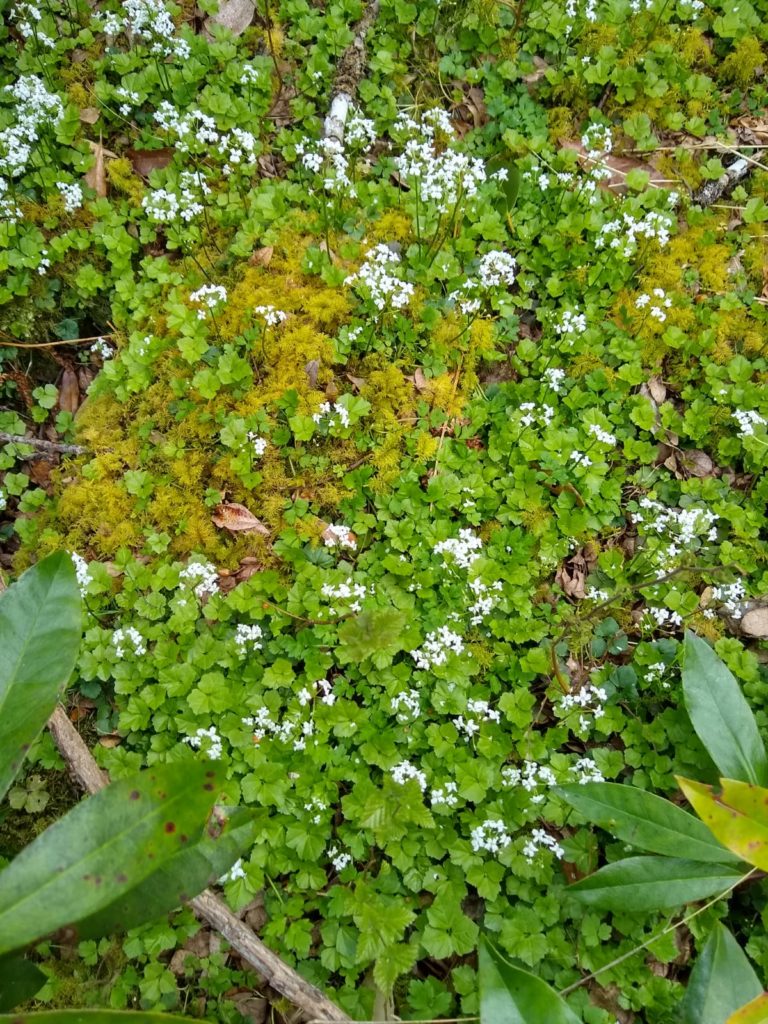
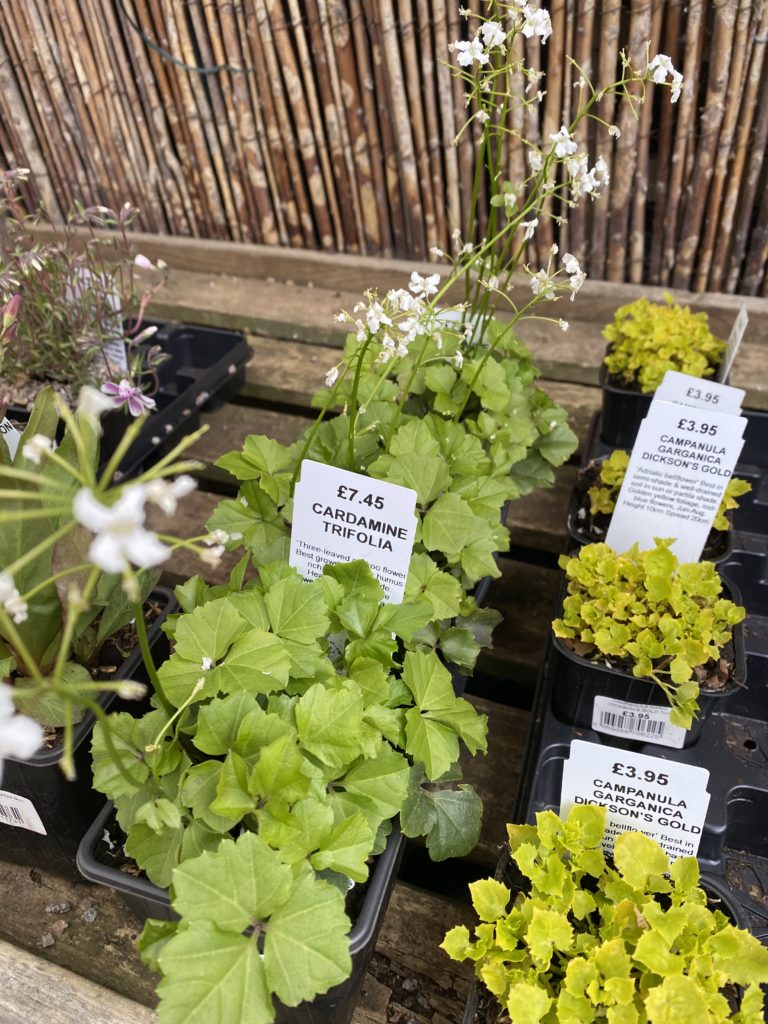
John Fletcher
Wonderful and fascinating scholarship. A joy to read.
Sue MacKay
Hi I am chair to Callander Heritage Society, whilst digitalising our archive I came across 2 pictures of Leny Glen after a Google search I came across your website. One is the same as your waterfall photo the other is taken at the same time and you don’t have a copy displayed here. It shows a small bridge and path.would you like a copy?